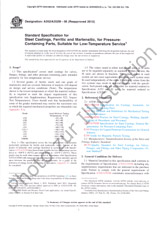Wir benötigen Ihre Einwilligung zur Verwendung der einzelnen Daten, damit Sie unter anderem Informationen zu Ihren Interessen einsehen können. Klicken Sie auf "OK", um Ihre Zustimmung zu erteilen.
ASTM C1463-19
Standard Practices for Dissolving Glass Containing Radioactive and Mixed Waste for Chemical and Radiochemical Analysis
Name übersetzen
NORM herausgegeben am 1.2.2019
Informationen über die Norm:
Bezeichnung normen: ASTM C1463-19
Ausgabedatum normen: 1.2.2019
SKU: NS-936786
Zahl der Seiten: 10
Gewicht ca.: 30 g (0.07 Pfund)
Land: Amerikanische technische Norm
Kategorie: Technische Normen ASTM
Kategorie - ähnliche Normen:
Die Annotation des Normtextes ASTM C1463-19 :
These practices cover three standard technique for dissolving glass samples containing radioactive, nuclear, and mixed wastes. These techniques used together or independently will produce solutions that can be analyzed by inductively coupled plasma atomic emission spectroscopy (ICP-AES), inductively coupled plasma mass spectrometry (ICP-MS), atomic absorption spectrometry (AAS), radiochemical methods and wet chemical techniques for major components, minor components and radionuclides. The practices for dissolving silicate matrix samples each require the sample to be initially dried and ground to a fine powder. The first practice involves the mixing and fusion of the sample with sodium tetraborate (Na2B4O7) and sodium carbonate (Na2CO4) in a muffle for a given amount of time and temperature. The sample is then cooled, dissolved in hydrochloric acid, and diluted to appropriate volume for analyses. The second practice, on the other hand, involves the fusion of the sample with potassium hydroxide (KOH) or sodium peroxide (Na2O2) using an electric bunsen burner, dissolving the fused sample in water and dilute HCl, and making to volume for analyses. Finally, the third practice involves the dissolution of the sample using a microwave oven. The ground sample is digested in a microwave oven using a mixture of hydrofluoric (HF) and nitric (HNO3) acids. Boric acid is added to the resulting solution to complex excess fluoride ions.
Keywords:
alkaline fusion, borosilicate glass, dissolving glass, ICP-AES, ICP-MS, microwave digestion, nuclear waste in glass,, ICS Number Code 13.030.30 (Special wastes)
Ergänzende Informationen
| 1. Scope | ||||||||||||||||
|
1.1 These practices cover techniques suitable for dissolving glass samples that may contain nuclear wastes. These techniques used together or independently will produce solutions that can be analyzed by inductively coupled plasma atomic emission spectroscopy (ICP-AES), inductively coupled plasma mass spectrometry (ICP-MS), atomic absorption spectrometry (AAS), radiochemical methods and wet chemical techniques for major components, minor components and radionuclides. 1.2 One of the fusion practices and the microwave practice can be used in hot cells and shielded hoods after modification to meet local operational requirements. 1.3 The user of these practices must follow radiation protection guidelines in place for their specific laboratories. 1.4 Additional information relating to safety is included in the text. 1.5 The dissolution techniques described in these practices can be used for quality control of the feed materials and the product of plants vitrifying nuclear waste materials in glass. 1.6 These practices are introduced to provide the user with an alternative means to Test Methods C169 for dissolution of waste containing glass in shielded facilities. Test Methods C169 is not practical for use in such facilities and with radioactive materials. 1.7 The ICP-AES methods in Test Methods C1109 and C1111 can be used to analyze the dissolved sample with additional sample preparation as necessary and with matrix effect considerations. Additional information as to other analytical methods can be found in Test Method C169. 1.8 Solutions from this practice may be suitable for analysis using ICP-MS after establishing laboratory performance criteria and verification that the criteria can be met. For example, Test Methods C1287 or C1637 may be used with additional sample preparation as necessary and appropriate matrix effect considerations. 1.9 The values stated in SI units are to be regarded as standard. Units in parentheses are for information only. 1.10 This standard does not purport to address all of the safety concerns, if any, associated with its use. It is the responsibility of the user of this standard to establish appropriate safety, health, and environmental practices and determine the applicability of regulatory limitations prior to use. 1.11 This international standard was developed in accordance with internationally recognized principles on standardization established in the Decision on Principles for the Development of International Standards, Guides and Recommendations issued by the World Trade Organization Technical Barriers to Trade (TBT) Committee. |
||||||||||||||||
| 2. Referenced Documents | ||||||||||||||||
|
Empfehlungen:
Aktualisierung der technischen Normen
Wollen Sie sich sicher sein, dass Sie nur die gültigen technischen Normen verwenden?
Wir bieten Ihnen eine Lösung, die Ihnen eine Monatsübersicht über die Aktualität der von Ihnen angewandten Normen sicher stellt.
Brauchen Sie mehr Informationen? Sehen Sie sich diese Seite an.




 Cookies
Cookies
